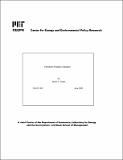Petroleum property valuation
Author(s)
Smith, James L.
Download2003-011.pdf (278.0Kb)
Other Contributors
Massachusetts Institute of Technology. Center for Energy and Environmental Policy Research.
Metadata
Show full item recordAbstract
This paper provides an overview of the principal economic methods employed to assess the value of petroleum properties. The difference between wellhead and in situ resource values is examined, as well as drawbacks inherent in the concept of "oil and gas equivalents." To be successful, any valuation method must correctly account for uncertainty - geologic as well as economic - and the value of flexible management in pursuit of optimal development and use of the resource. Although the traditional discounted cash flow (DCF) technique is workable and reasonably accurate in many applications, it presumes the analyst can clearly distinguish between systematic and non-systematic sources of risk. The real options approach may be better suited for applications where compound risks and managerial flexiibility are likely to have a significant impact on operations and economic performance. Options-based approaches have been employed within the industry for many years to account for the impact of price volatility and cost fluctuations. Assessing the value of a collection (portfolio) of geologically interdependent petroleum prospects requires a different form of real-options analysis since management holds the option to exploit information spillovers by exploiting prospects sequentially. Dependence among prospects gives value to this option and (perhaps contrary to popular belief) raises the value of the whole above the sum of its parts.
Date issued
2003Publisher
MIT Center for Energy and Environmental Policy Research
Other identifiers
2003-011
Series/Report no.
MIT-CEEPR (Series) ; 03-011WP.